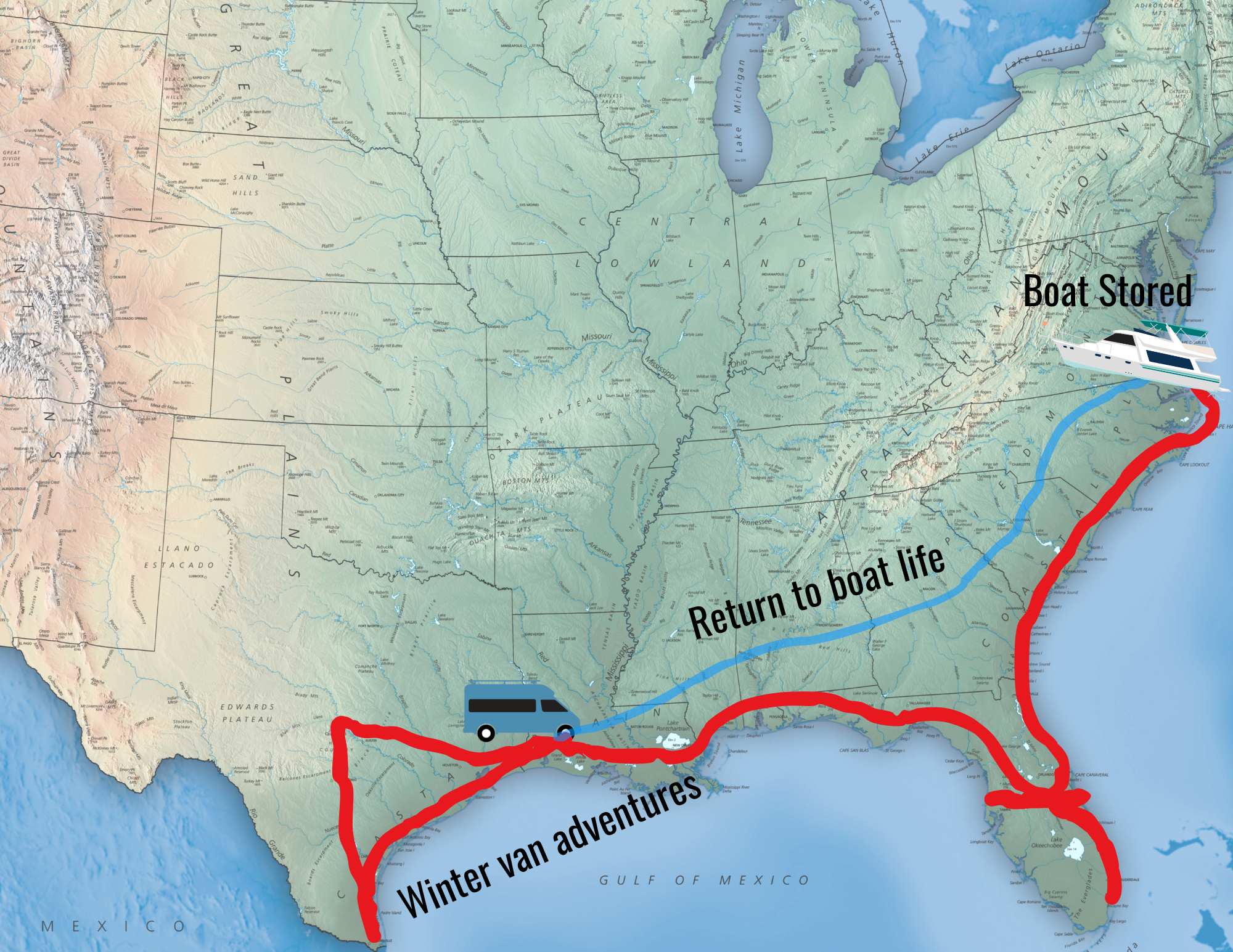This part of our growing series of our answers to the common excuses that folks give us for not getting out there and living the full time traveling lifestyle they want. You can catch the full series, which currently includes Jobs & Careers, Affording It, Stuff and Family.
An ever increasing number of people are growing concerned about the impact of their daily lives upon the environment, and many are taking proactive steps to minimize their impact and to be more conscious about consumption.

One excuse we’ll often hear from more eco-aware folks is that traveling full time would inevitably have too high of an environmental impact for them to consider leaving home without a heavy burden of eco-guilt.
This guilt is understandable – a life in motion consumes resources, and we certainly do not dispute the environmental impact of travel.
But we have discovered that “being green” while traveling is actually very achievable. And indeed, it is often possible to have less of an environmental impact living nomadically than by living a more typical lifestyle.
Each of us needs to find our own balance that combines exploring the world with preserving it. And if you stay conscious to your consumption, you don’t have to compromise your wanderlust for your desire to live a sustainable life.
Choose Greener Forms of Travel / Travel Slower
Every mode of transportation has a different footprint on the environment. Air travel is generally considered the dirtiest mode of transportation and walking/sailing the cleanest. The energy consumed in getting from place-to-place is one of the most substantial impacts a full-time traveler has.
One solution? Slow down!
Spend more time in one location and less time in actual transit. Stay in places long enough to get a feel for them, and immerse yourself in the communities you visit.
If you are keeping a relaxed enough pace, you will actually log a lot fewer miles than a typical suburb-to-city commuter will over the course of a year. And since you are not repeating the same route day after day, you will see SO much more of the world too!
Also consider greener ways you can get to where you want to be. For example – what about taking a slower route via rail or sailing ship, instead of flying? Or you can do like some nomads have and use human power to bike, walk or run.
Make the journey part of your destination and you’ll add value to your travel experience and decrease your impact while doing so.
For those, like us, who’s form of travel is physically moving their mobile house (RV or sailboat), find ways to green them as much as possible.
For instance, we’ve converted our electrical system to be run primarily off of solar power and our tow vehicle can run biodiesel. We even converted our small generator to run off propane to be a bit cleaner. Others, such as Vagabond Sean, have converted their rigs to run directly off of veggie oil and also utilize solar panels. Sean has even turned his adventuring into a crusade to remind folks he encounters that little changes go a long way.
There are resources such as Go Green Travel Green & Sustainable Travel which keep an eye on green travel options, and they’re great resources to check out for ideas. And for those that want to leave the driving to someone else. the Green Tortoise offers socially conscious travel adventures.
Reduce your Destination Impact
Once you’ve arrived to a place you’re planning to stay for a bit, find ways to reduce your impact and respect the local cultures while learning about them. Be there long enough to contribute to the community – either financially to the local economy and/or through volunteerism – to offset the impact to the earth of getting there. A full time traveler has a unique opportunity to have their visits to places be contributive overall.
Find ways to support local businesses, and eat foods grown and made locally. Eating locally reduces the impact to the earth for foods to catch up to you – and it helps you really experience the local environment. Seek out greener options for your lodging. Use public transit, walk or bike instead of driving around town whenever possible. Even though we have our tow vehicle (a Jeep Liberty Diesel), when we’re in areas with public transit we’ll make extra efforts to include mass transit in our local transit plans.
Be aware of your Impact
Sometimes, just being aware of your impact helps you reduce it. Prior to traveling full time, both Chris and I had a much higher impact in our more traditional dwellings. Just as some examples:
Fuel Consumption
Chris had an apartment in San Francisco and commuted 45 miles each way, daily. Even driving a Prius, he was consuming 40 gallons of gasoline a month just for his commute – he could easily use another 30 gallons a month for personal travel. Cherie worked from home and didn’t have a commute, but most of her miles on her Prius were on weekends to go visit friends – often involving about 30 gallons a month. Combined, that was a total of 100 gallons per month. Now that we’re traveling full time, we average about 40 gallons a month of fuel. And that’s even factoring in converting from driving a 45 mpg Prius to a 20 mpg Jeep!
With no work commute, and being able to choose how much travel we do – we can easily contain our fuel consumption costs and impact.
Water useage
Living off grid as much as possible and having to handle filling a fresh water tank and dumping grey water, makes you very aware of your water usage. When you can just turn on a water faucet in a traditional home without worrying about running out or having to find a way to dispose of the dirty water, it’s very easy to lose touch with how much water you’re using. Even if you look at your water bill monthly and see how much is used in a month, it’s really hard to quantify just what that means because you’re not handling it all at once.
I think before I hit the road my average water bill was for about 3000 gallons a month for my household of 3 adults (we used well water for our lawn, so that’s not even including that). That’s a 1000 gallons a month per person – which seems incredibly wasteful to me now.
Our trailer has a 32.5 gallon fresh water tank. It is not unusual at all for Chris, Kiki and I to go a week or two without needing to refill. We estimate that we now live well on less than 100 gallons a month .. combined. You can read more of our full report on how we conserve water.
Power Useage
Living off of solar for any extended period of time makes your VERY aware of your power consumption. We have just 110 amp hours of power available to us to use from our batteries (we try not to drop our 220 amp hour battery bank below 50%), plus whatever energy we create during daylight hours from our 200 watts of panels. Before hitting the road, I really had no concept of how how much energy that was or what I was actually using. But now, when I flip on a LED light, or power on my laptop, thanks to our battery monitoring system, I know exactly how much energy I’m depleting from our battery bank. If we’ve been really good about conserving power during the day, we’ll treat ourselves to watching a movie on our 24″ LCD panel – knowing that in doing so we’re using 16.7 amp hours in total.
If we were ever to move back into a more traditional dwelling situation (something that seems highly unlikely anytime soon), I know we’d live much differently after the lessons we’ve learned. So for us, traveling has actually increased our awareness of our impact, helped us consciously reduce it and taught us new lifelong habits.
———–



I looked around and could not find a list of the equipment that you use. I would love to read more about what equipment you use and why you chose it. I was, however, able to guess some from comments like “switching from a prius to a jeep”, LED lamps, iPhone, etc., but it would be nice to have that in one place. Like what type of panels and inverter do use use for your solar? Did you try out several systems, or just use the one that looked the best? Did you look into composting toilets? …
I love your site and look forward to reading more of your travels!
Thank you for stopping by
Getting a full list of our components is definitely on the list of things we need to do. Chris actually kept a pretty exhaustive journal on his personal blog during the customization and build process (at the time, technomadia.com was just a blog to keep our family & friends up to date on our travels), that is linked off of our Orion Tour:
http://radven.livejournal.com/tag/oliver
All the components were very thoroughly researched. I keep poking him to get his journal converted over to a digestible format here on Technomadia.
As far as our onboard tech, that is a page here which is located at:
https://www.technomadia.com/our-home/mobile-technology/
Hope that helps some.. I know we have a lot more to do to get all well documented If we could stop have so many darn awesome adventures, we might find the time to get it done.
If we could stop have so many darn awesome adventures, we might find the time to get it done.
– Cherie
A few short answers to your specific question….
I researched composting toilets, but the Oliver was already designed with traditional RV black / gray plumbing and it seemed like more trouble than it would be worth to try something different. If I was designing an RV from the ground up I might think otherwise.
The solar panels we bought are from AM Solar – they specialize in gear for RV’s.
The charge controller and battery monitor are from BlueSky Solar – I love the 2512ix and the IPN Pro Remote battery monitoring system. I used the same setup when I installed solar onto my Tab trailer.
The inverter is a 2000W Xantrex Freedom 458. I am not thrilled with how much power it “wastes” when it is on but driving a small load. I expected better.
The link Cherie gave points to a lot of in-depth comparative research I did when planning our systems. Someday soon I will update those articles, and move them over to this website.
Cheers!
– Chris
I wonder what the resources consumed and used to build a modern new home are generally. Whatever has to get torn up to make walls and such, but also all the resources used to get the materials onto the site, the workers to the jobsite to do the construction, etc. Not to mention all the resources used to heat/cool/operate such a building.
You 3 are hardly leaving a whisper, by comparison.
You’re absolutely right.. I hadn’t even considered the impact of building a home. Sure, an RV/boat/etc has build impacts involved, but not nearly that of a typical house.